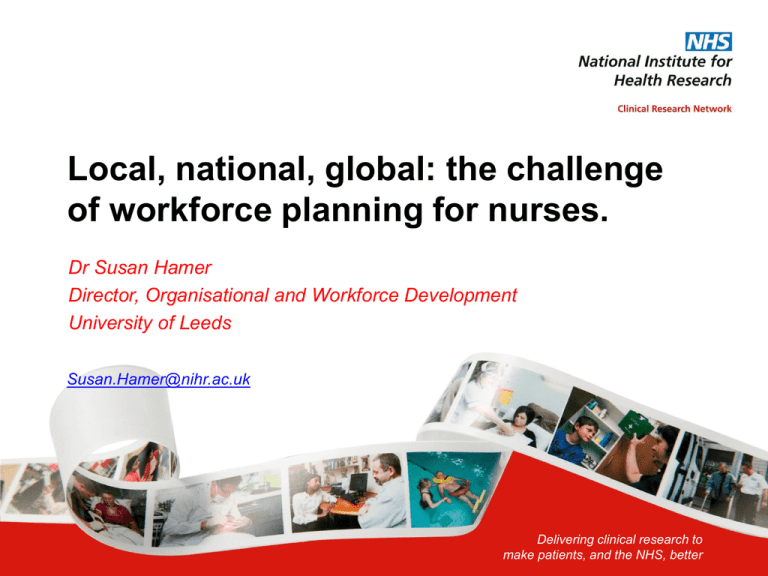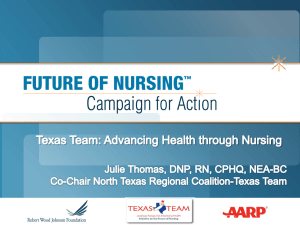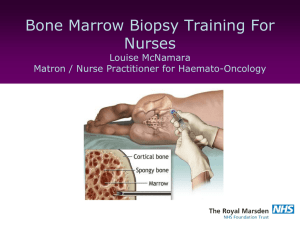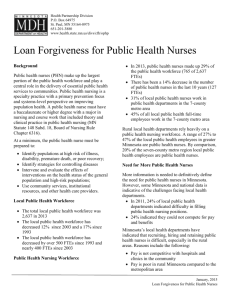International perspective
advertisement

Local, national, global: the challenge of workforce planning for nurses. Dr Susan Hamer Director, Organisational and Workforce Development University of Leeds Susan.Hamer@nihr.ac.uk Delivering clinical research to make patients, and the NHS, better International Nurses Day International perspective The World Health Assembly (WHA), the supreme decision making body of WHO, has repeatedly recognised the essential need for strengthening nursing and midwifery services in achieving better health for individuals, families and communities. The WHO progress report (2013b) describes achievements in response to the series of resolution adopted by the WHA to strengthen nursing and midwifery services. However this report concludes that in relation to the provision of health services many remain understaffed by nurses and midwives who in turn can be undertrained and poorly developed (WHO 2013b). International perspective Kingma (2007) concludes in a detailed study of global nurse migration, “Today’s search for labour is a highly organized global hunt for talent that includes nurses. International migration is a symptom of the larger systemic problems that make nurses leave their jobs. Nurse mobility becomes a major issue only in a context of migrant exploitation or nursing shortage. Injecting migrant nurses into dysfunctional health systems, ones that are not capable of attracting and retaining staff domestically will not solve the nursing shortage.” (p.1281) Health at a Glance 2009: OECD Indicators - OECD © 2009 - ISBN 9789264061538 3. Health workforce 3.8 Practising nurses Version 1 - Last updated: 19-Oct-2009 3.8.1. Practising nurses per 1 000 population, 2007 (or latest year available) 3.8.2. Change in the number of practising nurses per 1 000 population, 2000-07 Norw ay Ireland Sw itzerland Belgium Denmark Iceland Luxembourg Sw eden United States Finland United Kingdom Germany New Zealand Australia OECD Japan (2004-06) Canada (2003-07) Netherlands (2004-07) Czech Republic France Spain Austria 1 Italy (2004-07) Slovak Rep. (2000-04) Hungary Poland Portugal Korea Greece Mexico Turkey 31.9 Associate Practising nurses 40 30 15.5 14.9 14.8 14.3 14.0 11.0 10.8 10.6 10.3 10.0 9.9 9.9 9.7 9.6 9.4 9.0 8.7 8.0 7.7 7.5 7.4 7.0 6.3 6.1 5.2 5.1 4.2 3.2 2.4 2.0 20 10 0 n.a. 1.5 2.1 n.a. 2.4 0.8 n.a. 1.5 4.6 1.3 0.8 0.5 -0.7 1.4 2.0 1.5 -2.5 0.8 2.0 2.0 0.6 1.6 -3.9 2.1 0.6 4.8 4.9 • Multiple imbalances (undersupply, unemployment and underemployment) 2.8 0.7 2.6 -6 Per 1 000 population Security of Supply 0.6 -3 0 3 6 Average annual grow th rate (%) 1. Austria reports only nurses employed in hospitals. • Political interference 3.8.3. Ratio of practising nurses to practising physicians, 2007 (or latest year available) 10 • Gap between supply and demand 8.3 8 6 4 5.1 4.5 4.5 4.4 4.3 4.1 4.0 4.0 3.9 3.8 3.7 3.5 3.5 3.1 3.0 2.8 2.4 2.4 2.3 2.2 2.2 2.2 2.1 2.1 2.0 1.9 2 1.5 1.3 1.2 0.6 • Migration 0 • EU Mobility Source: OECD Health Data 2009. • Educational investment and systems Health professional education • Insufficient to address need • Mismatch of competencies to patient and population need • Persistent gender stratification of professional status • Quantitative and qualitative imbalances in the health care professions • Insufficient emphasis and time allocation for clinical learning; use of ineffective clinical teaching methodologies; unsuitable, poor quality or crowded clinical learning places; and a lack of good clinical role models. • Nursing faculty staff share the same demographic challenges as the rest of the workforce Changing Length of Nurse careers • • • • • • • • Changing working life span of the nurse workforce “Manpower planning models” Female dominated professions Different statutory pension ages Health workers tend to retire earlier (global trend) Different working patterns Age distribution of the workforce Weak approaches to workforce planning and management The Solution An educated nurse workforce + a good work environment = High quality care This simple, evidence based, equation, whether applied at a global or a local level in the health system is fundamental to understanding how to make the best of the vital resource which is nursing. A skilled nurse workforceright number, right place? • Have board level commitment (with a nursing director/chief nurse as a key requirement) • Actively involve staff and are transparent in their processes • Use established approaches and apply them consistently • Triangulate (e.g. dependency scoring system to gauge workload, professional judgement and benchmark) • Be evaluated regularly (against patient and staffing outcomes data) • Actively engage with the education sector and increasingly social care • Act on the results Support to change roles: who does what? • Role substitution (task shifting) • Increased complexity of interventions • Evaluating impact of new roles • Who pays? • Role of patients and communities When health professionals change fast: • • • • • • Supportive environments Right skill mix Effective leadership Expectation of change and authority to act Flexible regulatory environment Clinically attractive (innovation) A positive work environment Attribute 1: Shared core values. Attribute 2: Shared vision and mission with individual and collective responsibility. Attribute 3: Adaptability, innovation and creativity maintain workplace effectiveness. Attribute 4: Appropriate change driven by the needs of patients/ communities. Attribute 5 : Formal systems exist to continuously enable and evaluate learning, performance and shared governance (Manley et al 2011)











